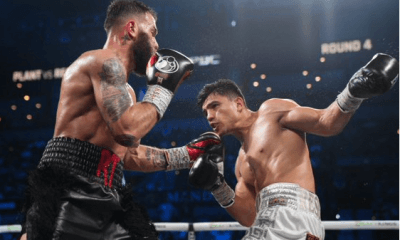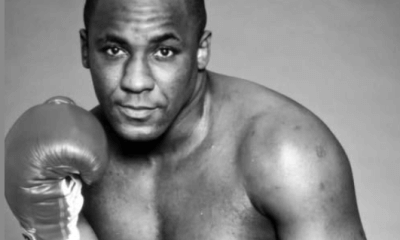Articles of 2007
Prediction Central: Cotto/Mosley
The sensational November 9 matchup between unbeaten WBA welterweight champion Miguel Cotto of Caguas, Puerto Rico, and four-time, multi-division champion Shane Mosley of Pomona, California, is being billed as “Fast and Furious.”
The title is certainly appropriate because most experts believe that the key components of the fight, which will be held at Madison Square Garden, will be the speed of Mosley vs. the furious pace that Mosley puts forth for every minute of every round.
What makes this fight so compelling is that anyone with even a rudimentary knowledge of boxing could easily make a strong case for either fighter to win or lose.
At 35 years of age, Mosley, 44-4 (37 KOS), has fought a who’s who of champions and contenders. His only losses were to Vernon Forrest and Winky Wright, both of whom outpointed him twice.
While Forrest and Wright are the slickest and savviest of boxers, it is hard to imagine Mosley being out-machoed by anyone.
However, the 27-year-old Cotto, 30-0 (25 KOS), is no ordinary macho man. While he is significantly slower than Mosley, as he has been against many other opponents, he is an absolutely relentless offensive machine who gives no quarter and expects none in return.
A former junior welterweight title holder, he has been dropped several times but has always got off the canvas to come back and win in dramatic fashion.
TSS interviewed 22 boxing insiders to get their predictions on this intriguing fight. What is most interesting about the poll is how evenly divided the predictions are:
Tim Smith, New York Daily News: “Although Mosley has the kind of power to finally get Cotto’s respect, I think his (Mosley’s) speed and experience will be the key factors. Cotto is a relentless guy who walks through everyone, but he’s never met anyone with the speed, power and smarts that Mosley has.” Mosley by decision.
Steve Farhood, ShoBox: The New Generation commentator: “This is a 50-50 fight and I would have no trouble picking either guy. Cotto has more to prove because there are still some question marks with him. Mosley’s wins over (Fernando) Vargas don’t really mean much. I think Cotto will overcome a Mosley points lead by stepping it up in the second half of the bout.” Cotto by decision.
David Diaz, current WBC lightweight champion: “Cotto is younger, hungrier, and will put lots of pressure on Mosley. Mosley is a great fighter, but I have to give the edge to Cotto. He is non-stop pressure, and the older Mosley will have trouble with that.” Cotto by late round stoppage.
Gerry Cooney, former heavyweight title challenger: “In his day Mosley was a much more explosive fighter than he is now. All around I think he is a better fighter than Cotto, but Cotto is young, aggressive and a real banger. Mosley will probably make Cotto look bad, but he’s been in lots of tough fights. I don’t know if Mosley can keep up with Cotto for 12 rounds. I’m going to take youth over age in this one.” Cotto by decision.
Calvin Brock, heavyweight contender: “This is a real good boxing match that I’m really looking forward to seeing. If Mosley looks as good as he did against Vargas, he could win. But Cotto seems unstoppable. Cotto just keeps getting better and better and he’s relentless. He’s in great shape and he never gets tired.” Cotto by decision.
Andy Lee, undefeated middleweight prospect: “Shane will win a few rounds early, but Cotto will eventually find his rhythm. He’s too young and aggressive and has too much speed and power for Mosley.” Cotto by TKO 11.
George Peterson, trainer and manager of welterweight contender Paul Williams: “Mosley has much more experience and speed. Plus he’s never been hurt, except for maybe a second against Vernon Forrest, and he came back fighting. Mosley has the edge.” Mosley by decision.
John Scully, current trainer and former light heavyweight title challenger: “I don’t think Mosley is as long in the tooth as the Cotto people hope he is or that many people believe he is. Cotto won’t be able to break down Mosley the way he did Judah. I’m going for the upset and pick Mosley to win a decision.”
Eileen Olszewski, top female flyweight contender: “Cotto has been knocked down a few times, but he always gets up and wins. I think the fight will go 12 rounds and that Cotto will win a decision.”
Joey Gamache, former WBA lightweight champion: “Cotto is too young and too determined, so I think he will win by decision or late round knockout.”
Sean Sullivan, Editor-in-Chief, Boxing Digest magazine: “Mosley needs to gets off with body shots to be effective. If I was Cotto, I’d be wary of Mosley’s body attack. Cotto will probably wear Mosley down and win a decision.” Cotto by decision.
Emile Griffith, multi-division champion: “This is a hard fight to pick, but I’m going with Cotto’s youth and undefeated record over Mosley’s experience. Cotto will somehow keep his undefeated record.”
Iran Barkley, multi-division champion: “This is a tough fight that is hard to call. I could see it going either way. This is a pick-em fight, but if you’re forcing me to make a pick I guess I have to go with Cotto, but not with a lot of faith.” Cotto by decision.
Bruce Silverglade, owner of Gleason’s Gym: “Style-wise this is an easy fight for Mosley. I was ringside when Cotto beat Zab Judah, and he looked very tough. But Mosley is an altogether different character. I think Mosley will stop Cotto late.”
Hector Roca, trainer: “This is a great fight, a toss-up. Mosley is very slick and Cotto is very tough. Cotto has problems with guys who move, like Paulie Malignaggi. He wasn’t able to stop him (Malignaggi), even though he beat him. Mosley will win a decision.”
Melissa “Hurricane” Hernandez, multi-division female champion: “I’m a huge Cotto fan, but Mosley is smart enough to box him. Cotto might stop him, but I have to pick Mosley by decision.”
Alicia Ashley, female super bantamweight contender: “Mosley is pretty fast, but will probably get caught by Cotto. I think Cotto will win handily by decision.”
Dave Selwyn: manager of female boxers Eileen Olszewski, Christy Nickel and Ronica Jeffrey: “Cotto will be Mosley’s toughest fight since Oscar De La Hoya. At this point of their careers, Cotto is younger and fresher.” Cotto by decision.
Tommy Dades, head coach at the Park Hill PAL Gym in Staten Island, New York, and lead investigator in the notorious Mafia Cops case: “Mosley is stronger, faster and more experienced. Cotto is an excellent fighter, but he hasn’t fought anyone like Mosley.” Mosley by decision.
Termite Watkins, former junior welterweight title challenger: “Cotto is a great young fighter who should probably win. But if anyone is going to upset him, it will be Mosley who is tested, proven, strong and fast.” Mosley by decision.
Teddy B. Blackburn: photographer: “If Mosley beat Oscar (De La Hoya) twice, he can beat Cotto once. Mosley by split decision in a very competitive fight.”
Bob Mladinich, TSS: “In almost every fight I have a good idea who the winner will be, even if I’m dead wrong. What makes this fight so great is the fact that I can’t pick a winner with any confidence at all. Even as I’m writing this I’m conflicted, but something tells me that Mosley will utilize his enormous offensive and defensive arsenal to win a hard fought decision.” Mosley by decision.
Totals:
Cotto: 12
Mosley: 10
-

 Featured Articles4 weeks ago
Featured Articles4 weeks agoA Night of Mismatches Turns Topsy-Turvy at Mandalay Bay; Resendiz Shocks Plant
-

 Featured Articles2 weeks ago
Featured Articles2 weeks agoAvila Perspective, Chap. 330: Matchroom in New York plus the Latest on Canelo-Crawford
-

 Featured Articles1 week ago
Featured Articles1 week agoVito Mielnicki Jr Whitewashes Kamil Gardzielik Before the Home Folks in Newark
-

 Featured Articles4 weeks ago
Featured Articles4 weeks agoRemembering the Under-Appreciated “Body Snatcher” Mike McCallum, a Consummate Pro
-

 Featured Articles4 weeks ago
Featured Articles4 weeks agoAvila Perspective, Chap 329: Pacquiao is Back, Fabio in England and More
-

 Featured Articles3 weeks ago
Featured Articles3 weeks agoOpetaia and Nakatani Crush Overmatched Foes, Capping Off a Wild Boxing Weekend
-

 Featured Articles3 weeks ago
Featured Articles3 weeks agoFabio Wardley Comes from Behind to KO Justis Huni
-

 Featured Articles2 weeks ago
Featured Articles2 weeks agoCatching Up with Clay Moyle Who Talks About His Massive Collection of Boxing Books















